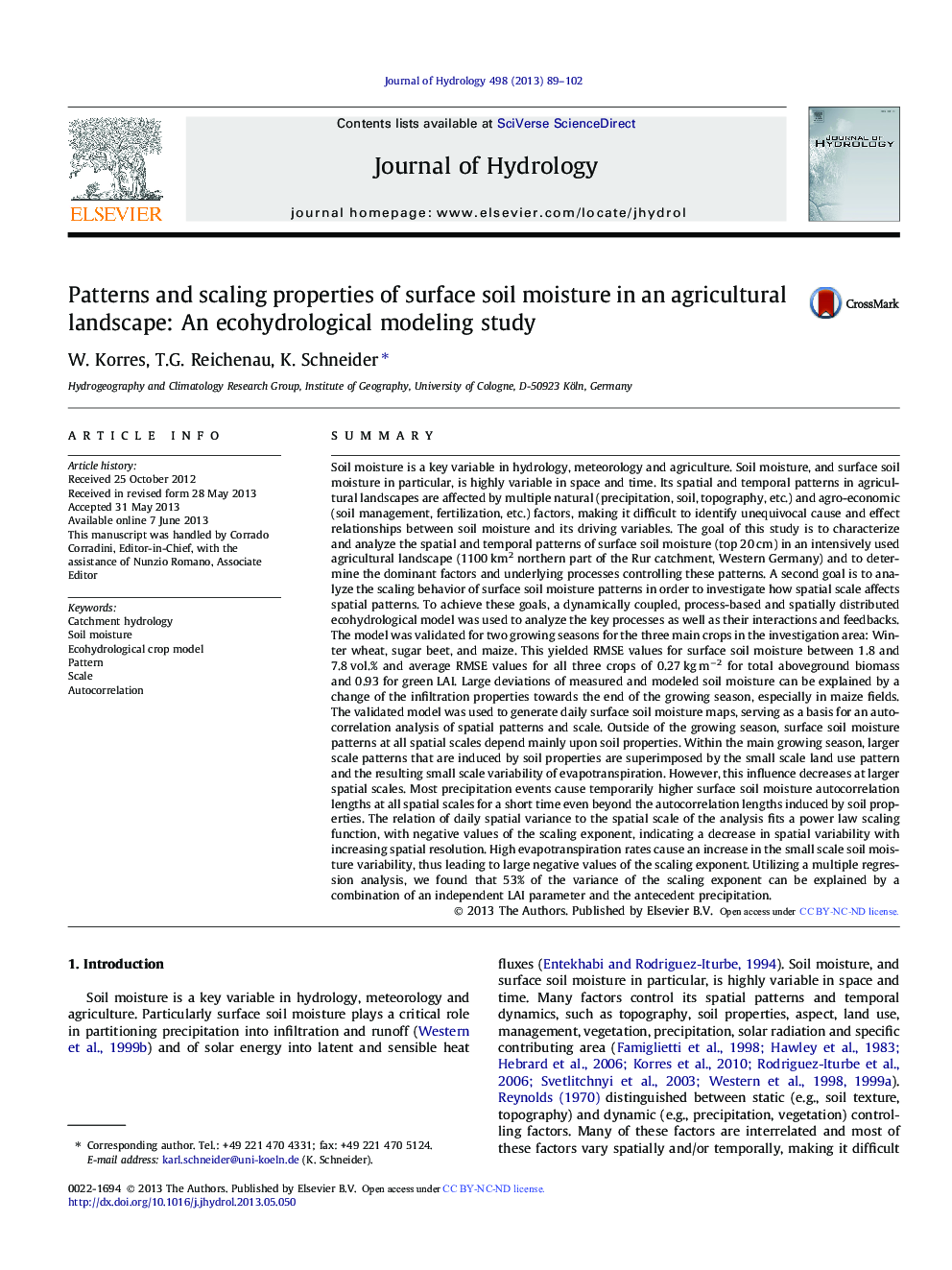| کد مقاله | کد نشریه | سال انتشار | مقاله انگلیسی | نسخه تمام متن |
|---|---|---|---|---|
| 6413560 | 1629950 | 2013 | 14 صفحه PDF | دانلود رایگان |

- Validation of a dynamically coupled and process-based ecohydrological model.
- Autocorrelation and scaling analysis of spatial surface soil moisture patterns.
- Patterns depend on soil properties, precipitation and land use heterogeneity.
- Evapotranspiration causes small scale patterns during growing season.
- Scaling factor depends upon LAI and precipitation.
SummarySoil moisture is a key variable in hydrology, meteorology and agriculture. Soil moisture, and surface soil moisture in particular, is highly variable in space and time. Its spatial and temporal patterns in agricultural landscapes are affected by multiple natural (precipitation, soil, topography, etc.) and agro-economic (soil management, fertilization, etc.) factors, making it difficult to identify unequivocal cause and effect relationships between soil moisture and its driving variables. The goal of this study is to characterize and analyze the spatial and temporal patterns of surface soil moisture (top 20 cm) in an intensively used agricultural landscape (1100 km2 northern part of the Rur catchment, Western Germany) and to determine the dominant factors and underlying processes controlling these patterns. A second goal is to analyze the scaling behavior of surface soil moisture patterns in order to investigate how spatial scale affects spatial patterns. To achieve these goals, a dynamically coupled, process-based and spatially distributed ecohydrological model was used to analyze the key processes as well as their interactions and feedbacks. The model was validated for two growing seasons for the three main crops in the investigation area: Winter wheat, sugar beet, and maize. This yielded RMSE values for surface soil moisture between 1.8 and 7.8 vol.% and average RMSE values for all three crops of 0.27 kg mâ2 for total aboveground biomass and 0.93 for green LAI. Large deviations of measured and modeled soil moisture can be explained by a change of the infiltration properties towards the end of the growing season, especially in maize fields. The validated model was used to generate daily surface soil moisture maps, serving as a basis for an autocorrelation analysis of spatial patterns and scale. Outside of the growing season, surface soil moisture patterns at all spatial scales depend mainly upon soil properties. Within the main growing season, larger scale patterns that are induced by soil properties are superimposed by the small scale land use pattern and the resulting small scale variability of evapotranspiration. However, this influence decreases at larger spatial scales. Most precipitation events cause temporarily higher surface soil moisture autocorrelation lengths at all spatial scales for a short time even beyond the autocorrelation lengths induced by soil properties. The relation of daily spatial variance to the spatial scale of the analysis fits a power law scaling function, with negative values of the scaling exponent, indicating a decrease in spatial variability with increasing spatial resolution. High evapotranspiration rates cause an increase in the small scale soil moisture variability, thus leading to large negative values of the scaling exponent. Utilizing a multiple regression analysis, we found that 53% of the variance of the scaling exponent can be explained by a combination of an independent LAI parameter and the antecedent precipitation.
Journal: Journal of Hydrology - Volume 498, 19 August 2013, Pages 89-102